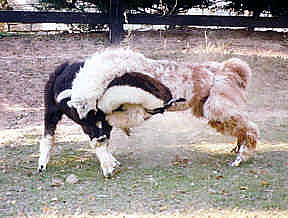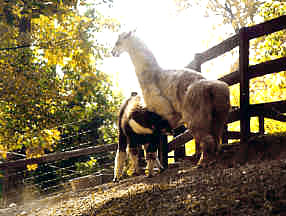



|
What Is It? Often referred to as Berserk Male Syndrome, and more recently referred to as Aberrant Behavior Syndrome (ABS), this is aggressive, un-mannerly behavior, and possibly will lead to extremely dangerous behavior in llamas and alpacas. Symptoms seen in a young animal may be jumping or rearing up, pushing against you, pulling on your clothes, getting in your face, being overly friendly and following you around trying to be very close to you, orgleing, or flipping their tail up over their back and dropping into a U-neck position when around people. This type of behavior, although it seems very innocent and perhaps cute when the animal is very young, becomes extremely dangerous as the animal matures - especially as he develops into breeding age and becomes territorial. There are many, many stories of owners suddenly finding their animals wildly charging at them from behind or rearing up at them screaming, spitting, and biting. It may happen with no warning whatsoever. Just one day as you're routinely bent over filling the water bucket, the animal comes charging from behind and smashes you to the ground. From there he may continue to stomp, bite, and scream viciously. Definitely scary, you'll consider yourself very lucky if you have no injuries. What Causes This Type Of Behavior? Unfortunately, this is not an inherited trait that just shows up in some lines - it is caused by over-handling by humans and the llama is the innocent victim. It is particularly common in males that have been taken away from their Moms, bottle fed, or overly handled and kitchy-koo'd alot. The animal grows to bond with humans rather than develop the social skills of the herd and, as he becomes older and breeding age, he suddenly looks at the human as his rival. Can Anything Be Done To Alleviate This Behavior? Any improper behavior seen in young llamas or alpacas needs to be addressed immediately and discipline given. Discipline can be as simple as a loud "No", a slight swat, or even a more firm "bringing your knee up into his chest" as he jumps up on you. If they continue to rush up to you and get really close "invading your space", some owners have found it effective to use a child's water blaster-gun in their face. If improvement isn't seen on the young animal right away, it probably is the best recommendation that he be gelded. Whatever method you choose to use, you must use firm and serious discipline! You are not being mean to the animal by administering discipline, but protecting him from being an unhandable outcast when he is older and most likely facing "being put down" because he is so dangerous. Here is a successful story from a breeder who recognized aggressive behavior early and with her approach, turned her male into a "treasure". "Paolo was the first problem baby male I have had in 22 years and did not know what to do with him. I got lots of input from other breeders and armed with that info, my vet and I decided to castrate him at 7 months. My vet saw that he could potentially be dangerous. She had just attended a llama vet meeting and they had discussed early castration. The consensus was that many of the vets in attendance are beginning to think that there is nothing wrong with doing castration early. My vet said if we saw any strange growth patterns we could always give hormone shots to compensate for the problem. So we watched his growth pattern very carefully. He had lived as a cria and baby with a herd of 12 females with his mother of course. When I weaned him at almost 6 months with one other little male, I noted that he was always invading my space and it made me very nervous, in my face, etc. Was making moves to treat me like another llama. He had not been overly involved with people just llamas. I had done all the normal things one does to discourage this type of behavior but nothing worked. When I was putting out feed in the barn one evening, he came up behind me and reared. I was aware that this might happen and I swung around with my arm full force and knocked him back. He stopped and then proceed to advance again. That did it. One time too many! He was castrated. After the castration I decided that none of the females and his mom had disciplined and taught him manners and he needed a 'reality check'. It might save his life. So I sent him to stay with a friend who has a whole herd of males, studs and others that range from 1 year to 5 years. He was not impressed in the beginning and continued his bad behavior even in these circumstances. He had no respect for his elders, even other llamas for sure. It was interesting because all the other llamas found his behavior unacceptable. For 3 days they never let him in the barn to eat, morning and night, at feeding time. They ran him off and it wasn't always the same male, Finally on the fourth day he walked goosed neck with his tail over his back and they then allowed him to come in an eat. I left him in that situation for 4 months. When he came home he was a different little guy. He is well behaved and totally trust worthy. HE JUST NEEDED TO BE TAUGHT SOME MANNERS and that male herd straightened him out. Regarding early castration, Paolo has grown normally, has great bone and is structurally a well developed llama. He was born in October of '98. My vet thinks that proper nutrition plays a big part in normal growth and with the diet that Paolo has had he proves out that theory, in his case anyway. No it's not a study but only a sample of ONE." The bad boy at Marian's Llamas is now a treasure!!! Marian Petey is a llama who was purchased cheaply at a livestock auction. " A few years back, one of the regular auction goers knew that I had llamas and bought a young (maybe 2 or 3 years) male for me. Of course this man is a "horse-trader" and made a healthy profit off of the llama. This llama is very smart, although not very pretty, and I worked with him for a few weeks doing the regular things, i.e. haltering, leading, etc. Then one day as I was approaching him to put his halter on, he reared up and "chested" me. It happened so fast that I didn't know what hit me! Fortunately, me husband was there and was able to keep Petey from causing further injury. My rotator cuff was torn and I had to undergo surgery to repair it - not fun! Bottom line is Petey is still here and will be until I can no longer function. I cannot sell him because he is dangerous and I refuse to kill him. It isn't his fault. He does get his toes trimmed and regular shots and worming, just like the rest of my llamas. I just make sure to have at least one other person around and I never turn my back on him. He used to spit at me every time I fed him, but I solved that problem by carrying a squirt gun and soaking him whenever he threatened to spit. He hasn't even threatened for a few years now." Ellen Diamond State Llama Farm, Delaware. An Extremely Dangerous Situation "We definitely need to have him moved as soon as possible, as he's getting way worse! He's now charging the fence at me from 50+ ft away and if I come closer, he rears up and tries to go over the fence! My husband is still able to feed him by threatening to squirt him with a water hose and getting in/out quickly, but that's not solving the problem nor is it safe for him to be doing this (especially by himself), so the sooner we can get him to someone to rehab the better."
Cria Behavior that may lead to Aggressive Behavior: |
Return To:
Llama Characteristics | Male Behaviors | About Llamas | Health Info
Shagbark Ridge Llamas/Hamilton Co. Llamas